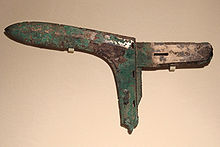- Dagger-axe
-
The dagger-axe (Chinese: 戈; pinyin: gē; Wade–Giles: ko; sometimes confusingly translated "halberd") is a type of weapon that was in use from Shang dynasty until at least Han dynasty China. It consists of a dagger-shaped blade made of jade (ceremonial), bronze, or later iron, mounted by the tang of the dagger to a perpendicular wooden shaft with a spear point. There is a variant type with a divided two-part head, consisting of the usual straight blade and a scythe-like blade.
Though the weapon saw frequent use in ancient China, the use of the dagger-axe decreased dramatically after the Qin and Han dynasties. By the medieval Chinese dynasties, the use of the dagger-axe was almost nonexistent. The horizontally aligned blade could be attached to a spear to form a much more useful polearm.
Generally, the Qin dynasty is noted as the most prolific user of the dagger-axe, with millions of these weapons produced. The use of the weapon involve thrusting the vertical spear head against the enemy's head as a feint. Then the user may cut the foe by pulling the scythe-like horizontal blade backwards. The cutting blade is angled optimally to behead the enemy.
Normally only the head of a dagger-axe is found, with the haft absent due to either decomposition or mechanical removal. Although the jade examples do not appear to have been intended for use in actual combat, their morphology closely imitates that of the battle-ready bronze version, including a sharp central ridge which reinforces the blade. Some dagger-axe artifacts are small and curved, and could have been intended for use as pendants.
Dagger-axes appear to have seen use in combat, though most examples are ceremonial jade weapons found in the tombs of aristocrats. These examples are often found within the coffins themselves, possibly meant to serve as emblems of authority and power, or in some other ritualistic capacity. Sometimes they are found in a pit dug beneath a coffin, with a victim who was sacrificed to guard the tomb, where they presumably are intended to keep the spirit-guard armed.
Dagger-axes were also experimental weapons of the Chinese, as this continued they were able to fuse their dagger-axe with the traditional spear to form a halberd.
See also
Types of Chinese weapons Short Swords Long Swords Polearms Roped/Chained Liuxing Chui (Meteor Hammer) 流星錘 · Sheng Biao (Rope Dart) 繩鏢 · Jiujie bian (nine section whip) 九節鞭 · Sanjie Gun 三節棍 · Shuangjie Gun 雙節棍Projectile Handheld Chui 錘 · Emeici 峨嵋刺 · Lujiao Dao (Deer Horn Knives) 鹿角刀 · Hook Sword 鉤 · Ji Lian 鷄鐮 · Fenghuo Lun 風火輪
Wikimedia Foundation. 2010.

